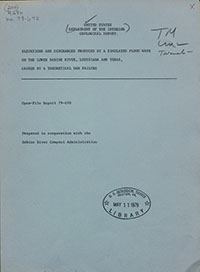Elevations and discharges produced by a simulated flood wave on the lower Sabine River, Louisiana and Texas, caused by a theoretical dam failure
Links
- Document: Report (pdf)
- Plate: Figure 11 (pdf)
- Download citation as: RIS | Dublin Core
Abstract
The Toledo Bend Reservoir is located on the lower Sabine River between Louisiana and Texas. The objective of this study was to calculate the flood wave that would result from the theoretical failure of 25 percent of Toledo Bend Dam and route the wave downstream to Orange, Tex. Computations assumed failure (1) at the peak of the 100-year flood when discharge of the Sabine River would be 102,000 cubic feet per second and (2) when the average discharge would be 10,000 cubic feet per second. Two techniques were used in the dam-break model. The method of characteristics was used to propagate the shock wave after the dam fails. The linear implicit finite-difference solution was used to route the flood wave after the shock wave has dissipated.
The magnitude of the flood was determined for sites near Burkeville, Bon Wier, Ruliff, and Orange, Tex., along the lower Sabine River. For these sites, respectively, the following peak elevations were calculated: 119, 82, 31, and 13 feet for the 100-year flood and 110, 75, 27, and 9 feet for the average discharge.
Study Area
| Publication type | Report |
|---|---|
| Publication Subtype | USGS Numbered Series |
| Title | Elevations and discharges produced by a simulated flood wave on the lower Sabine River, Louisiana and Texas, caused by a theoretical dam failure |
| Series title | Open-File Report |
| Series number | 79-678 |
| DOI | 10.3133/ofr79678 |
| Year Published | 1979 |
| Language | English |
| Publisher | U.S. Geological Survey |
| Description | Report: iii, 15 p.; 1 Plate: 15.62 x 24.28 inches |
| Country | United States |
| State | Louisiana, Texas |
| Other Geospatial | Sabine River |
| Google Analytic Metrics | Metrics page |


